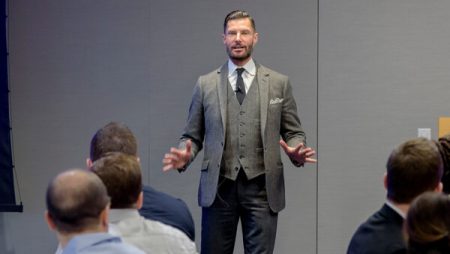



Get new exclusive access to healthcare business reports & breaking news




Todd Unger joined the American Medical Association (AMA) in 2017 as their first Chief Experience Officer (CXO) to transform how the AMA engaged with physicians and to expand membership. Prior to the AMA, Unger led digital-change initiatives at AOL, Time Inc. and the Daily Racing Form.
Todd is currently spearheading the AMA’s digital transformation strategy, and with only 20 months under his belt, he has doubled the AMA’s member growth rate and greatly expanded its digital audience.
I had the opportunity to sit down with Todd and learn more about growth marketing from one of the best. Here is what I learned from him about marketing and digital transformation.
You’ve led some successful digital transformations, most recently at Daily Racing Form, which seems very different than the AMA – Can you break down your approach in the early stages?
Move fast, start small, and rack up quick wins.


I don’t start with “digital blinders.” I start as a marketer trying to understand the customer and the key growth levers, which inevitably lead to digital solutions in this day and age. It’s important to get to a vision fast at this stage. If you truly listen and dig into the data, you can generate a high-level road map and identify key potential growth opportunities within a couple weeks. From there, it’s about bringing others on board and proving out the story.
Every time I start a large program with a lot of unknowns, I focus on our ability to get quick “digital” wins that our teams can rally behind as positive momentum. To get these quick wins, I start with identifying how our customers interact with us digitally and then create segmentation models based on that data. This new segmentation model impacts everything from our content strategy to products we’re creating.
Often, there are quick wins that can be delivered through analytics and testing. For example, the team quickly boosted the AMA website and email conversion rates through implementing consistent A/B testing. Find 5 of these improvements and you can quickly make a positive impact proving to stakeholders that you’re a difference maker. That creates believers and buys permission to do more things even faster.
Your Title is Chief Experience Officer (CXO), which is still considered a new title. What does your role entail and how does it fit within the organization?
This is a “buck stops here” role that the new digital era demands. A person who is not just responsible for the end-to-end set of interactions with the customer, but also for driving growth. This requires a leader who can oversee all aspects of the customer experience including marketing, product and design, and content.
A lot of folks associate customer experience with live experiences, mapping out the “magic moments” that surprise and delight customers. With a limited number of live events, the AMA’s challenge is defining and scaling a digital experiences that resonate with our audience, particularly with content. At the AMA, this means partnering very closely with our Mission-based teams to help them reach more people with all of the incredible research, education, tools and knowledge they create.
When you joined the AMA, how did you collect data to understand your members’ needs & wants?


Todd Unger presenting in front of AMA members
First, by good old fashioned listening.
One of my first customer interactions was with a physician who reached out to me on LinkedIn and told me he didn’t think the AMA represented him.
Pardon the pun, but it didn’t take a brain surgeon to figure out the big opportunity: instead of explaining how the AMA represented him or just ignoring the message, I got on a flight the next morning to meet him. He, like so many other physicians, had little awareness of what the AMA was doing and achieving on behalf of physicians and patients.
There is just no substitute for face-to-face interactions, and I’ve met a ton of the most wonderful physicians and students! But obviously I can’t get on a plane to meet every single member. That’s where data comes in. We’ve used data to create far more effective customer segmentation models and deliver a more personalized, relevant experience across the site and all digital marketing platforms.
Doubling the AMA’s membership growth rate is impressive. Can you tell me more about some of the tactics you used to get that growth?
The first thing I noticed: there wasn’t a “join” button at the top of our site. But that was just the tip of the digital marketing iceberg. Every aspect of the site had to be re-built and optimized before we could move up from the bottom of the funnel.
While that was happening, we started analyzing how people were interacting with our site and email communications, and that led to a watershed moment: we needed to enhance our customer segmentation. Once that was in place, it drove everything.
The Membership Moves Medicine(™) campaign grew out of our customer segmentation and provided a roadmap to create more relevant engagement with members and non-members alike. The campaign tells the story of how the AMA and its members are moving medicine for the better and making a huge difference together.
This includes powerful “proof points” that quantify the value of AMA’s activities and the recognition of our members in photos, video, articles, podcasts, you name it. One of my favorite things is we got rid of all stock photos on the site and replaced them with our heroes: real physicians, residents and students.
How do you get others on-board with change?


You’ve got to engage people in the hard work of transformation. You need to move with energy, but steamrolling is not an effective strategy. I work hard to build an organization-wide team that understands and believes in the change we need to make.
When I first got to the AMA, I went on a hunt looking for other “productive disruptors” like me who would partner on digital initiatives and experiments. These relationships blossomed into recognized strategic partnerships, and through success, led to even more people joining our “productive disruptor” cause.
Lastly, how did you get into marketing?


I was lucky to land at Procter & Gamble out of college, and after business school spent 7 years in advertising at Leo Burnett. Those 10 years gave me the foundation for my digital career. How to analyze research, communicate persuasively, lead teams, to segment and define a consumer positioning, and most importantly, how to tell a story that inspires people.
The digital world allows you to do those things 10X. For me, it’s the ultimate combination of creativity and business, because it unleashes the capacity for testing ideas and frees them from a battle of personal opinions. In the end though, it all comes down to seamlessly integrating product, marketing, design and technology in the service of a real customer need. That’s fun!
Thanks for a great interview, Todd. Your commitment to data, understanding of customers, and ability to execute highly effective marketing campaigns through creating great customer experiences is bar none.
Are you interested in other exceptional leaders who are helping their organizations adopt new technologies and reinvent themselves? Check out our interview with David Badri, the Johnson & Johnson Virtual Reality Program Lead which helps doctors & medical residents get better at their job.